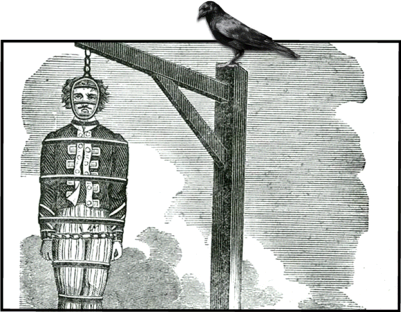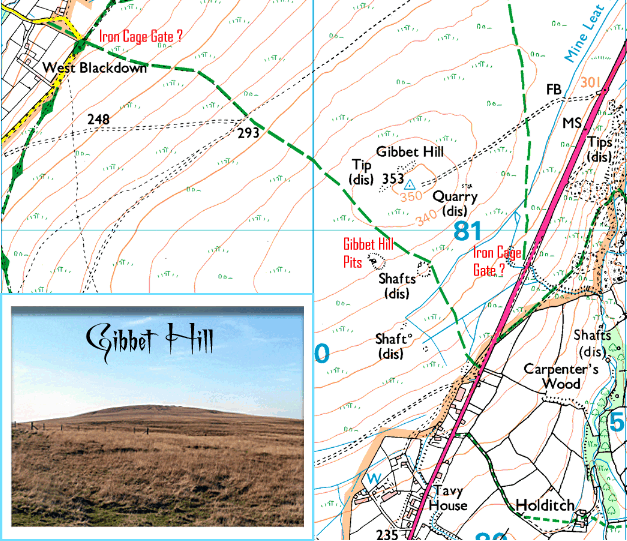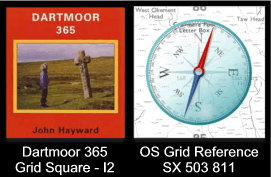
“Rolling featureless in a great, rounded mass on the western frontiers of Dartmoor; marked only by the occasional pit or mound, where man has burrowed without success for metal; its mighty back close-coated in ling and heath and the lesser whin, there heaves up Gibbet Hill.” Eden Phillpotts, Gibbet Hill, 1910.
When travelling along the A386 between Okehampton and Tavistock you pass under the huge dome of a hill which over time has witnessed both scenes of celebration and of tribulation. On most maps the hill is known as Gibbet Hill but it has also gone under the name of Gallows Hill. In days of yore the A386 was a busy route carrying coaches, wagons, riders and pedestrians and was the supposed haunt of several highwaymen such as Captain Jack and Dick Rawley It was said that he and several other criminals ended up on the gibbet which gave this hill it’s various names. History has it that Dick Rawley was the last highwayman to be hung on the gibbet on Gibbet Hill. Apparently he was finally captured when found hiding in one of the old mining pits at the old Wheal Betsy mine. In England the Murder Act of 1751 gave judges the power to sentence criminals to the gibbet and this was especially handed out to murderers, sheep stealers and highwaymen. In some cases the gibbet consisted of a metal cage into which the prisoner was left to die of starvation and hunger. In other forms they would consist of a simple upright post from which an arm extended at ninety degrees on which the criminal’s dead body would be left to decompose. The idea of such things was to act as a reminder to folk exactly what the penalty for committing such crimes would be so they were often located at prominent points in the landscape such as at crossroads or beside public highways. In this light Gibbet Hill was the ideal site to locate such a feature as it would have been in full view of the travellers along the busy road below. There is some confusion as to exactly what the ‘gibbet’ consisted of and to whether or not it was a cage into which the criminals were pit or a simple post from which their corpses were dangled. As can be seen from the map below there are two possible locations where a gate known as the ‘Iron Catch Gate’ was located and in one sense these could allude to being a gate through which a route led to the ‘Iron Cage’? However, there is a local tradition that the cage was actually located at the site of the gate and the criminals were held here before being taken up to the gibbet on the top of the hill?
Today all vestiges of gibbets, cages and dead bodies swinging in the wind have long since disappeared and all that can be found on the summit of the hill is a trig pillar (No. S3450 for anyone interested). It is from this lofty height of 353 metres that wide ranging views can be seen ranging in all directions. The prominence of the hill made for an ideal location for a prehistoric barrow as reported in 1891: “On Black Hill (Gibbet Hill as it is locally called), near Lydford Station, are the remains of a barrow, and the summit of the hill on which it stands has been smoothed off level, affording a considerable area.” TDA, 1891, p.118. A few years later one writer lamented in a local newspaper that: “It is unfortunate that so much spoilation of the few objects of antiquity to be formerly seen on Black Down has taken place… Quite recently the remnants of a cairn that once surmounted Gibbet Hill, the loftiest eminence in the parish, have disappeared.” – The Devon & Exeter Gazette, 1903. So, as can be gathered there is little point in searching for the monument as in all likelihood the stones were ‘recycled’ for building purposes like many of Dartmoor’s other prehistoric monuments.

There are a few stories associated with Gibbet Hill, William Crossing tells how; “Tales are related in the neighbourhood of unfortunate wretches being confined there in an iron cage and left to die, as a punishment for their crimes on the highway. It is told of one that existed for a considerable time in the cage, the country people supplying him with food, and that he was sometimes so ravenous that he had been known to devour candles, when the market folk going homeward had nothing better to offer him.” Whilst on the subject of Gibbet Hill Crossing also mentions that this was where the evil Lady Howard was burned. pp.30 -33. Another one being that years ago a criminal was put in the cage to await his end and after many days began to starve. It is said that to get some much needed nourishment he ate the flesh of his arms. Another equally gruesome tale was that a local criminal was put in the cage and in order to stop him dying of thirst his mother breast fed him through the bars of the cage which seems a bit far fetched. Eden Phillpotts was a master at weaving some facts along with various traditions and tales into his fictional Dartmoor stories. Gibbet Hill is one example as in his Tales of the Tenements written in 1910 he tells of how two men engaged the help of a local journeyman to saw down the gibbet and the cage along with its occupant and toss it down one of the old nearby mine shafts known as Gibbet Hill Pits. In 1910 Philpotts wrote a short story for Harper’s Monthly Magazine called ‘ Gibbet Hill’ which told the story of a local farmer who owned Gibbet Hill Farm, a widow woman and her waster of a son. There is a brief mention in the story of the actual gibbet when the farmer says; “When I was young a gallows stood ‘pon top of Gibbet Hill, and they hanged a good few night-birds there – hanged ’em to rot in chains – just for a warning. ‘Tis a pity they don’t do the same still. Such as your son want such reminders.” In another of his works – A Mother for Heroes – Gibbet Hill makes another appearance; ” A real gibbet stood on Gibbet Hill, out Blackdown way, in them days, and one thing those bold scamps did on a moonshiny night was to ride that way and cut down Sual Pratt, the Brent sheep-stealer. Saul was a noted person, and was said to belong to they Gubbinses of Lydford, who would keep savage whether or no, and never neighboured with decent people, and lived like savage tigers in caves and holts. But he was catched and sent for death and hung in chains for a terror and a warning to the countryside. His carcass, according to the custom of them days, was lifted in an iron cage and left there till the carrion crows pecked his bones to pieces through the bars and let ’em drop down. But Fagg and Blackadder didn’t like this ugly sight, so they stopped a journeyman carpenter out Bridestowe way, and took a gert saw from his bag, and with it they sheared off the gallows tree a foot above ground, and topples it and the cage and the remains of Saul Pratt all together into the shaft of a tin mine a hundred yards away.”

Gibbet Hill has also been a place for celebration and has been used on several occasions to light signal bonfires, although not officially noted as a beacon site. In 1897 Gibbet Hill was a link in a chain of fires lit to commemorate Queen Victoria’s Diamond Jubilee. Local men were sent to Coryton with wagons and horses to collect wood for the bonfire. Six men then built the bonfire which at the time was said to have been a good 35 feet high with a barrel crowning its top. At 10.00 pm. a rocket was sent skywards and the bonfire was lit and it was reported that over 100 other such fires could be seen from the hill. – The Western Morning News, June 24th, 1897. In 1902 another commemorative bonfire was lit on Gibbet Hill, this time supposedly to celebrate the coronation of King Edward VII. I say supposedly because the King was suddenly taken ill with an abdominal abscess and the event had to be postponed until he recovered. However, the bonfire was lit although; “the number present were not large, the weather being anything but favourable for a visit to a lofty height on an open down. An immense area of West Devon and East Cornwall is commanded from the Gibbet and a large number of fires were seen. But in the wet, misty night they lost much of their brightness, and except some of the nearer ones, they seemed to burn with a dull, red glow. A lack of interest was displayed, for though the bonfire was being lighted it could not be forgotten that nothing was being commemorated.” – The Devon & Exeter Gazette, July 4th, 1902.

Brent, F. 1891. The Thirteenth Report of the Barrow Committee – Transactions of the Devonshire Association – Vol. XXII. Plymouth: Brendon & Son.
Crossing, W. 1987. One Hundred Years on Dartmoor. Exeter: Devon Books.
Hayward, J. 1991. Dartmoor 365. Curlew Publications

“Stand by triangulation pillar No. 3450 on the summit of the hill for a magnificent panorama of Dartmoor tors. Not only is the whole line of western heights in view, but beyond them if visibility is good the innermost crests of the blanket bog, Black Ridge and Cut Hill, form a grey horizon… The hill is so named because there was indeed a gibbet up here, a specially built one that had an iron cage suspended from its arm. In this cage malefactors were imprisoned and left to die. The former road from Tavistock to Okehampton ran over the hill so that passing folk could treat the prisoner to a crust of bread or a feat of invective, as they felt inclined.” Hayward, p.140.
 Legendary Dartmoor The many aspects past and present of Dartmoor
Legendary Dartmoor The many aspects past and present of Dartmoor

Hello
my names David i am 15 and I live in near black down. I am an army cadet and thoroughly enjoy walking, Since I was a toddler I have been walking up to Gibbet hill. I have walked to the top in every season, I have seen it when its been snowing and the pond has frozen over with a layer 3 to 4 inch layer of ice. I have seen it when the pond has completely dried up and disappeared and I’ve seen it carpeted in fog and rain. I have heard small snippets of information about the hill but I’ve never managed to find out as much information as I would have liked to. This information was really fascinating to me and I am glad when I walk up with friends i can tell them about all the stories this hill has. Thank you
Hi David, Glad it was of some interest.
For a number of years during the 1950s it was the routine for my brother and I, together with our father, to walk up to Gibbet from our home near Brentor station after lunch on Christmas Day. It served the dual purpose of releasing pent up energy and stimulating our appetites for Christmas tea! Following our father’s example we carried up a stone to deposit at the summit. I have never discovered if this was a practice he instigated or if it was a continuation of a more ancient tradition.